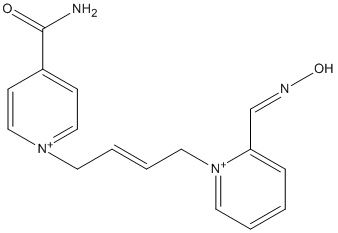BI-6
General
Type : Oxime, Bispyridinium, Carboxamide
Chemical_Nomenclature : 1-[4-[2-(nitrosomethyl)pyridin-1-ium-1-yl]but-2-enyl]pyridin-1-ium-4-carboxamide
Canonical SMILES : C1=CC=[N+](C(=C1)CN=O)CC=CC[N+]2=CC=C(C=C2)C(=O)N
InChI : InChI=1S\/C16H17N4O2\/c17-16(21)14-6-11-19(12-7-14)8-3-4-10-20-9-2-1-5-15(20)13-18-22\/h1-7,9,11-12H,8,10,13H2,(H-,17,21)\/q+1\/p+1
InChIKey : BJTLWOFUMXTEKF-UHFFFAOYSA-O
Other name(s) : 1-2-hydroxyiminomethylpyridinium-4 carbamoylpyridinium-2-butene dibromide
MW : 298.33
Formula : C16H18N4O2
CAS_number :
CID PubChem :
InChIKey UniChem :
Iuphar :
Wikipedia :

Target
Structure : No structure
Families : No family
References
No reference